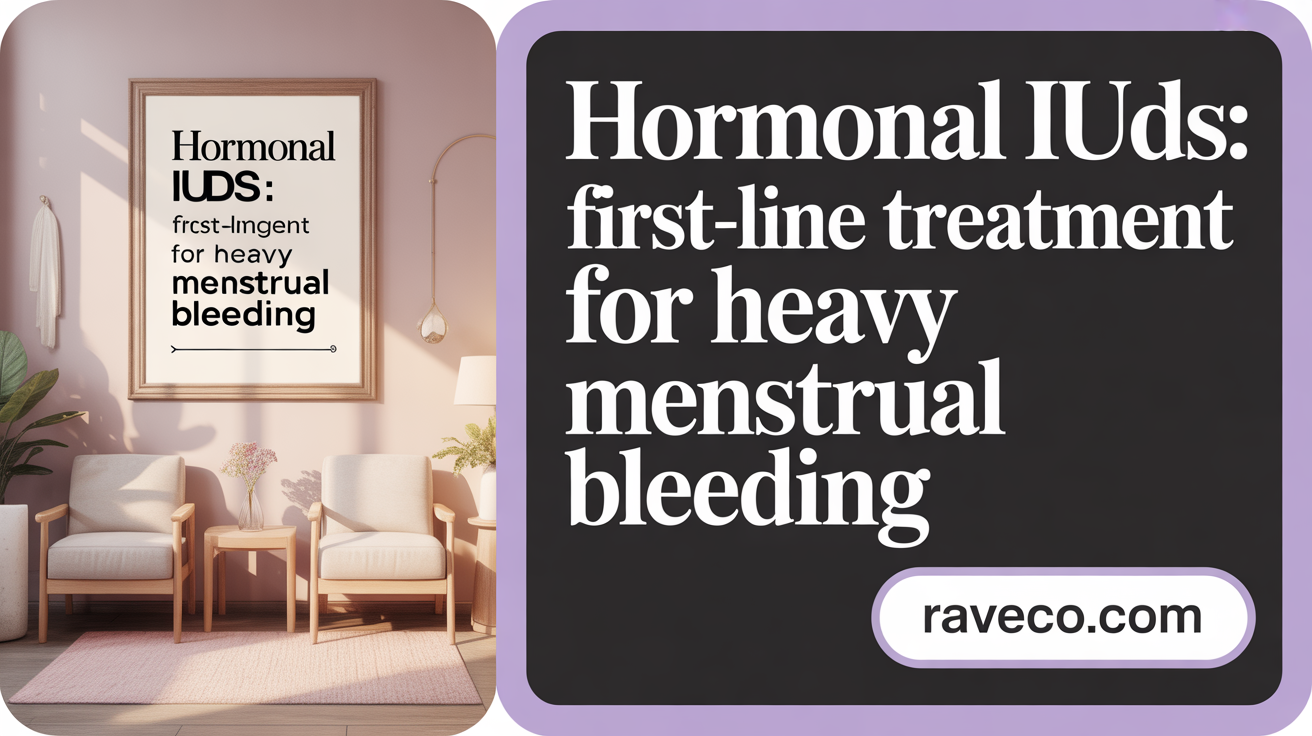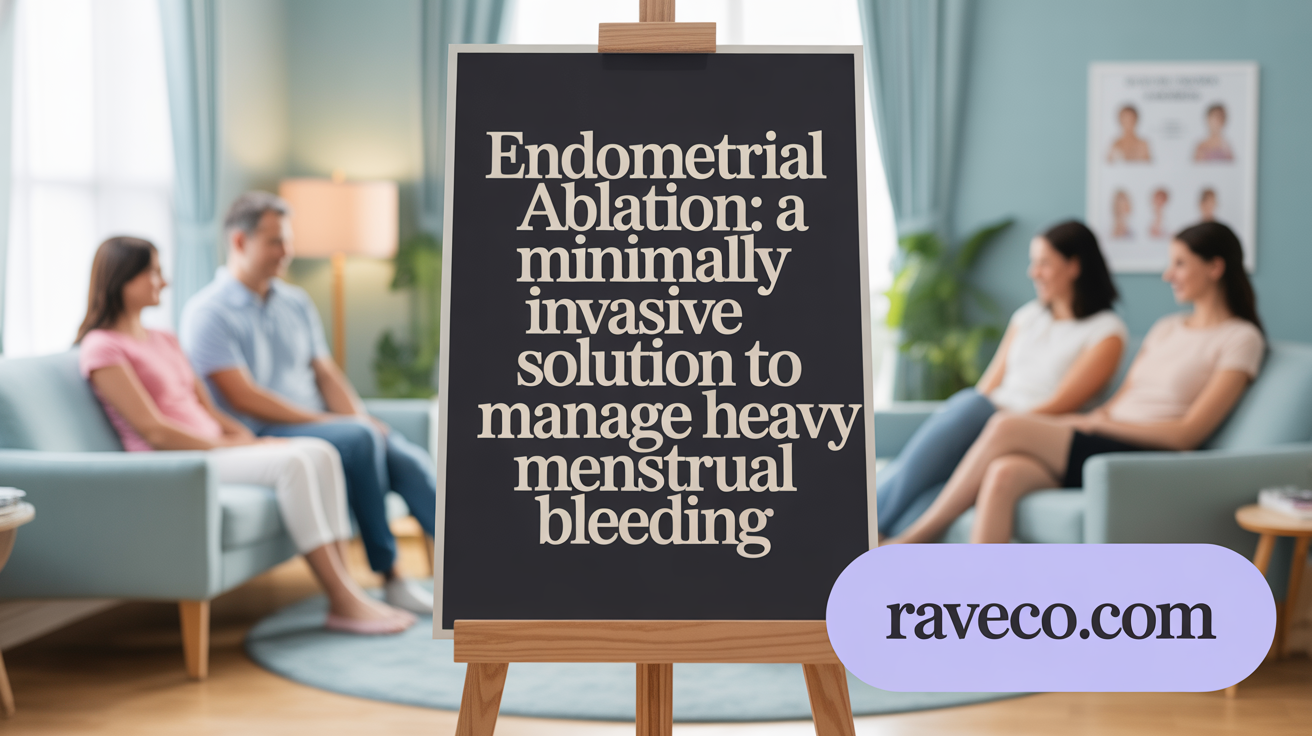Recognizing the Right Time to Address Female Infertility: Key Indicators and Expert Care in Queens

Understanding Heavy Menstrual Bleeding and Treatment Choices
Heavy menstrual bleeding, medically termed menorrhagia, can severely disrupt a woman’s life, causing inconvenience, pain, and anemia. Effective treatment depends on accurate diagnosis, the severity of symptoms, underlying causes, and patient-specific factors such as age and fertility desires. This article outlines the top three most effective medical procedures for treating heavy bleeding, from minimally invasive to definitive surgical options, offering a comprehensive perspective for informed decision-making.
Key Facts on Treatments for Heavy Menstrual Bleeding
- The LNG-IUS is a highly effective, reversible first-line treatment reducing menstrual bleeding by over 90%.
- Endometrial ablation is a minimally invasive surgical technique that destroys the uterine lining to significantly reduce or stop bleeding.
- Hysterectomy offers a permanent solution by removing the uterus, eliminating menstrual bleeding, but ends fertility and carries surgical risks.
- Medical therapies, including NSAIDs, hormonal contraceptives, and tranexamic acid, are effective first-line options with minimal invasiveness.
- Treatment choice depends on severity, fertility desires, and underlying conditions, with options ranging from medication to surgery.
- Guidelines like NICE recommend starting with less invasive treatments and escalating based on individual response and preferences.
- Surgical options like hysteroscopic removal of fibroids/polyps or endometrial ablation are suitable when medical therapy fails or is inappropriate.
- Patient-centered care with shared decision-making ensures treatment aligns with individual reproductive goals and health status.
- Minimally invasive surgeries, such as hysteroscopic myomectomy, offer shorter recovery and are preferred when preserving fertility.
- Effective management emphasizes a stepwise, evidence-based approach balancing efficacy, safety, and patient preferences for optimal outcomes.
1. Hormonal Intrauterine Device (IUD): A First-Line Minimally Invasive Procedure

Use of levonorgestrel-releasing intrauterine system (LNG-IUS) in heavy bleeding
The levonorgestrel-releasing intrauterine device (LNG-IUS) has become a popular first-line treatment for women suffering from heavy menstrual bleeding, also known as menorrhagia. This small device is inserted into the uterus by a healthcare provider and is designed to deliver a steady dose of the hormone levonorgestrel directly to the uterine lining.
How the LNG-IUS works to reduce menstrual blood loss
The primary mechanism of the LNG-IUS involves thinning the endometrial lining of the uterus. Since the amount of bleeding during periods largely depends on the thickness of this lining, reducing its proliferation effectively decreases menstrual flow. The hormone also thickens cervical mucus and suppresses ovulation, which contribute to lighter periods.
Suitability for women wanting long-term treatment and fertility preservation
One of the notable advantages of the LNG-IUS is its suitability for women who wish to manage heavy menstrual bleeding while preserving their fertility. Unlike hysterectomy, which removes the uterus, the LNG-IUS is reversible. Women can choose to have the device removed when they wish to conceive, making it an attractive option for those planning future pregnancies.
Efficacy and safety profile of LNG-IUS
Studies have shown that the LNG-IUS significantly reduces menstrual blood loss, often by more than 90% within the first few months of use. Many women experience a marked improvement in their symptoms, with some even becoming amenorrheic (having no periods at all). Its safety profile is generally excellent; common side effects include irregular bleeding during the initial months, but serious adverse effects are rare.
How it compares with other medical therapies
Compared to other medical options such as oral hormonal contraceptives or NSAIDs, the LNG-IUS offers longer-lasting relief without the need for daily medication. Its local hormone delivery minimizes systemic side effects often associated with oral therapy. Additionally, unlike oral treatments, the LNG-IUS can be an effective option for women with contraindications to systemic hormones or those who prefer a 'set-it-and-forget-it' approach.
Duration and reversibility of treatment effects
The effects of the LNG-IUS typically last between 3 to 7 years, depending on the specific product used. When removed, most women resume their normal menstrual cycles, and fertility returns quickly. This reversibility provides women with flexibility and control over their reproductive health.
| Feature | Details | Additional Notes |
|---|---|---|
| Effectiveness | >90% reduction in menstrual bleeding | Within months of insertion |
| Duration of Use | 3 to 7 years | Varies by device |
| Reversibility | Yes | Fertility returns after removal |
| Common Side Effects | Irregular bleeding, spotting | Usually transient |
| Major Benefits | Non-invasive, reversible, suitable for fertility preservation | Preferred first-line treatment |
The LNG-IUS continues to be a highly recommended approach for managing heavy periods, combining effectiveness with safety and convenience. Women interested in this treatment should consult their healthcare provider to determine if it is suitable for their specific medical conditions and reproductive plans.
2. Endometrial Ablation: A Targeted Surgical Approach to Reduce Menstrual Flow

What is endometrial ablation and how is the procedure performed?
Endometrial ablation is a minimally invasive surgical technique designed to permanently destroy the lining of the uterus, called the endometrium. The procedure involves the use of heat, cold, or radiofrequency energy to remove or destroy this uterine lining, which is responsible for menstrual bleeding. It is typically performed as a day procedure under local or general anesthesia, often with hysteroscopic guidance, allowing the doctor to see inside the uterus and precisely target the lining.
How does endometrial ablation reduce or stop heavy menstrual bleeding?
By destroying the endometrial tissue, endometrial ablation significantly decreases the amount of bleeding during periods. Since menstruation is triggered by the shedding of the uterine lining, removing or damaging this tissue prevents or lessens the shedding process. Many women experience a substantial reduction in menstrual flow, with some even achieving complete cessation of bleeding.
Who is a suitable candidate for endometrial ablation?
This procedure is mainly recommended for women who have completed their childbearing, as the uterine lining is permanently ablated, and pregnancy afterward is not possible. It is considered for women experiencing heavy menstrual bleeding that has not responded to medication or other conservative treatments. Doctors evaluate individual health conditions and reproductive plans before suggesting this option.
How effective is endometrial ablation in controlling symptoms?
Research shows that endometrial ablation effectively reduces menstrual bleeding in approximately 80-90% of women. Many patients report relief from heavy bleeding, flooding, and prolonged periods. Additionally, the procedure can improve quality of life by alleviating issues associated with menorrhagia, such as fatigue, anemia, and social limitations.
How does endometrial ablation compare with more invasive surgical options?
Compared to hysterectomy, which involves removing the entire uterus, endometrial ablation is less invasive, has fewer risks, and typically involves a quicker recovery. While hysterectomy offers a definitive solution and guarantees no recurrence of bleeding, it is major surgery with longer hospitalization and recovery times. Endometrial ablation serves as a middle-ground, providing significant symptom relief for women who prefer to avoid major surgery and still maintain some uterine function.
What are the potential risks and side effects?
Endometrial ablation procedures are generally safe, but they carry some risks. Possible side effects include bleeding, cramping, infection, or injury to the uterus. In rare cases, the uterine lining may regenerate, leading to ongoing bleeding. Women may also experience complications related to anesthesia or adhesion formation. It's important to discuss individual health risks with a healthcare provider.
What should be considered regarding day procedure and recovery?
Most women can return home the same day as the procedure. Recovery usually involves mild cramping, which can be managed with pain relievers, and the patient is advised to rest for a day or two. Vaginal discharge and light bleeding, similar to a period, can occur for a few days to weeks. Sexual activity and tampon use are usually discouraged for a short period following the procedure. Follow-up appointments are recommended to monitor healing and effectiveness.
This targeted surgical option offers a promising alternative to more invasive procedures for women seeking relief from heavy menstrual bleeding. The decision to pursue endometrial ablation should be made in consultation with a healthcare professional, considering individual health status and reproductive goals.
3. Hysterectomy: The Definitive Surgical Solution for Severe Cases
What is a hysterectomy and when is it performed?
A hysterectomy is a surgical procedure that involves the removal of the uterus. It can be partial, removing just the uterine body, or total, which includes removing the cervix. This operation is considered when other treatments for heavy menstrual bleeding, such as medications and less invasive procedures, have failed or are not suitable.
Why might a woman need a hysterectomy for heavy menstrual bleeding?
Hysterectomy is often recommended for women experiencing debilitating heavy menstrual bleeding (menorrhagia) that significantly impacts their quality of life. It is usually indicated when bleeding is caused by severe uterine abnormalities such as large fibroids, adenomyosis, or endometrial pathology that do not respond to conservative therapies. Moreover, women with underlying conditions like certain cancers or extensive endometrial diseases may also be candidates.
How does a hysterectomy serve as a definitive treatment?
This surgery provides a permanent solution by directly removing the source of abnormal bleeding—the uterus. Once the uterus is removed, menstrual bleeding ceases entirely, eliminating heavy bleeding symptoms and related issues like anemia or pain linked to uterine problems.
What are considerations regarding fertility and surgical risks?
- Fertility: Hysterectomy ends a woman’s ability to bear children, which is a significant factor to consider. It is usually reserved for women who do not desire future pregnancies.
- Risks: As a major surgical procedure, hysterectomy carries potential risks such as bleeding, infection, damage to surrounding organs (bladder, bowel), blood clots, and anesthesia-related complications. Recovery generally involves several weeks of rest, and some women may experience hormonal changes if the ovaries are also removed.
What is the recovery process and long-term effects?
- Recovery: Typically, women stay in the hospital for 1-3 days post-operation, depending on the method used (abdominal, vaginal, or laparoscopic). Full recovery can take up to 6 weeks, during which activity levels should be gradually increased.
- Long-term effects: Women may experience menopause symptoms if the ovaries are removed, including hot flashes and vaginal dryness. Psychological impacts, such as feelings of loss or relief, are also common and should be addressed with support.
How does hysterectomy compare with less invasive options?
Hysterectomy is considered the last resort after less invasive treatments fail or are inappropriate. Alternatives such as endometrial ablation or uterine artery embolization offer symptom relief without removing the uterus, preserving fertility and reducing surgical risks. It is usually recommended when other options are ineffective or unsuitable for the patient's condition.
Which patients are suitable candidates and what guidelines are followed?
- Patient selection: Suitable candidates are women with persistent heavy bleeding unresponsive to conservative treatments, with no desire for future pregnancy. Evaluation of uterine pathology and overall health status is critical.
- Guidelines: Clinical guidelines recommend considering hysterectomy when the health benefits outweigh the surgical risks, and after a comprehensive discussion about all available options and their implications.
| Aspect | Details | Additional Notes |
|---|---|---|
| Indications | Severe fibroids, adenomyosis, endometrial cancer, unmanageable menorrhagia | Often after failed medical or minimally invasive procedures |
| Approach | Abdominal, vaginal, laparoscopic, or robotic | Minimally invasive methods tend to reduce recovery time |
| Risks | Bleeding, infection, organ injury, hormonal effects | Preoperative evaluation helps minimize risks |
| Impact on fertility | Eliminates fertility | Important consideration for women seeking children |
| Postoperative recovery | 1-6 weeks | Varies based on surgical approach |
| Long-term effects | Menopause if ovaries removed | Hormone replacement therapy may be needed |
Hysterectomy remains a vital option for women with severe, unmanageable heavy menstrual bleeding, especially when other treatments have not provided sufficient relief. It offers a definitive solution but requires careful patient selection and preoperative planning to ensure safety and satisfaction.
Comprehensive Overview: What Are the Most Effective Medical Procedures for Treating Heavy Menstrual Bleeding?

What are the most effective medical procedures for treating heavy menstrual bleeding?
Treating heavy menstrual bleeding (HMB) effectively depends on the root cause, the severity of symptoms, and whether the woman wishes to maintain fertility.
First-line medical treatments often provide significant relief with less invasiveness. Hormonal intrauterine devices (IUDs), especially those releasing levonorgestrel, are among the most effective options. These IUDs can drastically reduce menstrual volume and are suitable for women who wish to avoid surgery.
Medications such as tranexamic acid, an antifibrinolytic, help slow bleeding by promoting blood clot stability. NSAIDs like ibuprofen and diclofenac are also frequently used; they not only reduce pain but can decrease blood loss by approximately 20-46%. Hormonal contraceptives, including birth control pills, patches, and vaginal rings, suppress ovulation and thin the uterine lining, leading to lighter periods.
In cases where medication fails to control bleeding, surgical options are considered. Endometrial ablation destroys or removes the lining of the uterus to reduce or halt menstruation. It’s a minimally invasive procedure suited for women who no longer desire children. Myomectomy involves removing fibroids—benign uterine tumors—that contribute to heavy bleeding, especially when preserving fertility is important.
Hysterectomy, which entails removal of the entire uterus, is the most definitive solution and is typically reserved for severe cases or when other treatments have failed. It ensures the cessation of menstrual bleeding but is more invasive and results in infertility.
When are surgical procedures indicated?
Surgical interventions are usually recommended if medical therapy does not adequately control symptoms or if there is an underlying pathology such as fibroids, polyps, or abnormal endometrial tissue. They are also chosen when rapid symptom relief is needed or when women no longer wish to have children.
What range of surgical options are available?
- Endometrial Ablation: A day procedure that destroys the lining, effective in reducing or stopping bleeding.
- Myomectomy: Removal of fibroids; performed via hysteroscopic, laparoscopic, or open approach.
- Uterine Artery Embolization: Blocks blood flow to fibroids, causing them to shrink.
- Hysterectomy: Complete removal of the uterus, offering a permanent solution.
Factors influencing treatment choices
Treatment decisions depend on various factors. Symptom severity and impact on quality of life are primary considerations. Fertility goals are critical—women wishing to conceive may prefer myomectomy over hysterectomy.
Underlying uterine conditions, such as fibroids or polyps, guide the selection of specific procedures. Age, overall health, and personal preferences also play roles.
Emphasizing collaboration for individualized care
Choosing the appropriate treatment involves thorough discussion between the woman and her healthcare provider. Comprehensive evaluation—including pelvic imaging and blood tests—helps identify the cause of bleeding and tailor the intervention.
In summary, a range of medical and surgical options are available for managing heavy menstrual bleeding. The most effective approach hinges on individual circumstances, emphasizing personalized planning with professional guidance.
Understanding Available Surgical and Non-Surgical Treatment Options for Heavy Menstrual Bleeding
What are the surgical and non-surgical treatment options available for heavy menstrual bleeding?
Heavy menstrual bleeding, also known as menorrhagia, affects many women and can significantly impact daily life. When addressing this condition, healthcare providers consider several treatment avenues based on the cause, severity, and the woman’s reproductive goals.
On the non-surgical side, hormonal therapies are commonly first-line options. These include hormonal contraceptive pills, patches, rings, and intrauterine devices (IUDs) that release levonorgestrel. These methods help regulate menstrual cycles, lighten periods, and reduce excessive bleeding. Additionally, medications like tranexamic acid and NSAIDs (such as ibuprofen or diclofenac) are effective in decreasing bleeding volume and alleviating associated pain.
When medications are insufficient, surgical procedures come into play. Dilation and curettage (D&C) involves scraping or suctioning tissue from the uterus lining, typically to diagnose or treat bleeding abnormalities. Endometrial ablation destroys or removes the lining of the uterus, considerably lightening or stopping menstrual flow—mainly suited for women who do not wish to conceive in the future.
More invasive options include myomectomy, which removes fibroids that may cause heavy bleeding, and hysterectomy, the complete removal of the uterus, which is considered the most definitive treatment especially for women who have completed their pregnancies.
Less invasive surgical methods, such as uterine artery embolization, block blood flow to fibroids to shrink them, reducing bleeding and other symptoms. Hysteroscopy allows for targeted removal of polyps or fibroids through a small camera inserted into the uterus.
How to decide between non-surgical and surgical approaches?
The decision depends on multiple factors. For instance, women desiring future pregnancies might prefer less invasive options like myomectomy or uterine artery embolization. Those who have completed their families, or for whom medications have failed, might opt for a hysterectomy or endometrial ablation.
The severity of bleeding and underlying causes also influence choices. For example, large fibroids or complex endometrial pathology might require surgical intervention. Overall health conditions and patient preferences play crucial roles in crafting an individualized treatment plan.
What about minimally invasive surgical techniques?
Minimally invasive procedures, such as hysteroscopic myomectomy or endometrial ablation, offer benefits like shorter hospital stays, quicker recovery, and less pain. These techniques are often suitable for women who want effective results with less downtime.
Why is personalized care important?
Every woman's situation is unique. Proper evaluation—including medical history, physical exam, ultrasound, or hysteroscopy—guides the choice of treatment. Understanding the underlying cause, fertility desires, and overall health ensures that the selected approach offers optimal outcomes. Consulting with a gynecologist helps create a tailored strategy that balances effectiveness and safety for each patient.
How Are Treatment Procedures Selected? Criteria and Guidelines for Managing Heavy Menstrual Bleeding

Importance of individualized clinical assessment including history, imaging, and laboratory tests
Effective management of heavy menstrual bleeding (HMB) begins with a thorough evaluation of the patient. Healthcare providers gather detailed medical histories, including menstrual patterns, clotting tendencies, and reproductive goals. Physical exams focus on identifying uterine abnormalities such as fibroids, polyps, or endometriosis.
Diagnostic imaging, like ultrasound or hysteroscopy, helps visualize uterine structures and pinpoint causes. Laboratory tests, including blood counts, ferritin levels, and assessments for coagulation disorders, aid in understanding the severity and underlying etiology. This comprehensive assessment ensures that treatments are tailored to address specific causes rather than applying a one-size-fits-all approach.
Role of guidelines such as NICE in guiding evidence-based treatment selection
Clinical guidelines, such as those from the National Institute for Health and Care Excellence (NICE), provide evidence-based frameworks for managing HMB. These guidelines recommend starting with the least invasive options, such as hormonal intrauterine devices (IUDs) like the levonorgestrel-releasing IUD, which are highly effective and preserve fertility.
They also emphasize the importance of patient-centered care, advocating for shared decision-making and considering individual preferences, severity of symptoms, and reproductive plans. When initial medical therapies fail or are unsuitable, guidelines suggest advancing to minimally invasive procedures like endometrial ablation or more definitive surgeries including hysterectomy.
Factors influencing procedure choice: bleeding severity, impact on quality of life, fertility desires, underlying conditions
The decision-making process considers several key factors:
- Severity of bleeding: Women experiencing daily disruptions or significant anemia are more likely to require surgical intervention.
- Impact on quality of life: Persistent fatigue, pain, or emotional distress may prompt more aggressive management.
- Fertility desires: Women wishing to conceive are usually managed with fertility-preserving procedures like myomectomy or medical therapies, whereas women who do not want children may consider hysterectomy.
- Underlying conditions: Uterine abnormalities such as fibroids or polyps influence choice; for example, fibroid removal (myomectomy) may be preferred if fibroids are the cause.
- Response to previous treatments: Failed medical management necessitates exploring procedural options.
Through careful evaluation, clinicians can recommend the procedure most suited to the individual’s circumstances, balancing efficacy and safety.
Shared decision making between patient and clinician
Shared decision-making is pivotal in HMB management. It involves open discussions about the benefits, risks, and implications of all treatment options. Patients are informed about the potential effects on fertility, sexual function, and hormonal balance.
Examples include explaining that hormonal IUDs are reversible and highly effective, but some women may experience irregular bleeding initially. Surgical options like hysterectomy offer definitive resolution but are more invasive.
Empowering women with knowledge and respecting their preferences facilitates choices aligned with their values and life plans, thereby improving satisfaction and adherence.
Balancing efficacy, safety, and patient preferences for optimal outcomes
The optimal management of heavy menstrual bleeding hinges on balancing treatment efficacy with safety and individual preferences. Medical therapies—such as NSAIDs, hormonal contraceptives, and antifibrinolytic agents—are first-line, offering non-invasive solutions with minimal risks.
When medical options fail or are unsuitable, procedures like endometrial ablation or uterine artery embolization can effectively reduce bleeding. Hysterectomy remains a definitive solution for women who have completed childbearing or when other treatments are ineffective.
Throughout, clinicians must consider the patient's overall health, presence of comorbidities, and personal reproductive goals. Regular follow-up ensures that chosen interventions achieve desired outcomes while minimizing adverse effects.
| Treatment Approach | Typical Use | Risks & Considerations | Reproductive Impact |
|---|---|---|---|
| Medical therapies | First-line, reversible | Side effects vary; effectiveness depends on cause | Usually preserves fertility |
| Endometrial ablation | For those not wishing future children | Not suitable if pregnancy is desired; possible recurrence | Typically permanent, no pregnancy afterward |
| Uterine artery embolization | For fibroids causing bleeding | Potential for post-procedure pain, rare complications | Fertility may be affected; generally not recommended for women trying to conceive |
| Hysterectomy | Definitive treatment | Major surgery, longer recovery, risks of anesthesia | No fertility after removal |
Choosing the right approach involves an individualized assessment and open discussions, ensuring treatments align with the woman’s health, preferences, and lifestyle.
Balancing Effectiveness and Safety: Considerations for Different Heavy Bleeding Treatments
What are the efficacy and safety considerations of different treatments for heavy menstrual bleeding?
Treatment options for heavy menstrual bleeding, also known as menorrhagia, vary considerably in their effectiveness and safety profiles. The choice of treatment depends on individual patient factors, including severity of bleeding, reproductive desires, and overall health.
Hysterectomy, the surgical removal of the uterus, is the most definitive option and offers the highest likelihood of complete symptom resolution. However, it is a major surgery with associated risks such as infection, bleeding, and longer recovery times. Additionally, hysterectomy renders women unable to bear children.
Endometrial ablation, a procedure that destroys the uterine lining, provides significant symptom relief with fewer complications. It is generally safe and performed as a day procedure. However, it is suitable only for women who do not wish to conceive in the future and may not guarantee complete symptom resolution.
Medical treatments are often the first line of therapy. Nonsteroidal anti-inflammatory drugs (NSAIDs) like ibuprofen and diclofenac reduce menstrual blood flow and pain, typically effective in 20-46% of cases. Hormonal therapies including hormonal contraceptives, levonorgestrel-releasing intrauterine systems (LNG-IUS), and progestin-only pills are effective in decreasing bleeding volume and are well tolerated.
Tranexamic acid, an antifibrinolytic medication, reduces bleeding by preventing clot breakdown and is FDA approved for heavy menstruation. It is considered safe and effective, with minimal side effects.
Surgical options such as hysteroscopy and myomectomy can remove fibroids or polyps causing bleeding and are suitable if medications don’t work.
While more invasive procedures carry higher risk profiles, they are often necessary for cases unresponsive to medical management or with structural abnormalities.
How do these treatments impact long-term health and fertility?
Hysterectomy permanently eliminates menstrual bleeding but at the cost of fertility loss. It’s suitable for women who no longer wish to conceive.
Endometrial ablation may impact future fertility, as it damages the lining of the uterus, and is generally recommended only for women who have completed childbearing.
In contrast, procedures like myomectomy and uterine artery embolization aim to preserve fertility, though they carry their own risks and may require future interventions.
Medical therapies, especially hormonal treatments, are typically reversible and pose minimal long-term health risks.
What about side effects and patient compliance?
Side effects of medications vary. NSAIDs generally cause gastrointestinal discomfort; hormonal therapies may lead to irregular bleeding, headaches, or mood changes. Tranexamic acid and other antifibrinolytics are well tolerated but require adherence to dosing schedules.
Surgical options, while often more effective in the long term, involve anesthesia, recovery periods, and possible complications such as infection or scar formation.
Patient compliance is crucial, especially with medical therapies. LNG-IUS, for example, offers long-term protection with minimal maintenance once inserted, leading to better adherence.
How can we balance treatment benefits and risks?
Personalized treatment plans should consider the patient’s reproductive plans, severity of symptoms, risk tolerance, and lifestyle. For women desiring future pregnancy, conservative treatments like hormonal IUDs or myomectomy are preferable.
For those seeking definitive resolution and no longer wishing to conceive, hysterectomy may be suitable despite the higher upfront risks.
Evidence supports the safety and efficacy of the LNG-IUS and tranexamic acid as first-line options due to their favorable risk profiles. These treatments have demonstrated good symptom control and quality of life improvements with minimal adverse effects.
Choosing the appropriate therapy involves an informed discussion about the balance of risks, benefits, and individual preferences, ensuring optimized patient outcomes.
Evidence-Based Clinical Guidelines and Strategies for Managing Heavy Menstrual Bleeding
What are evidence-based strategies and clinical guidelines for managing heavy menstrual bleeding?
Managing heavy menstrual bleeding (HMB), or menorrhagia, involves a comprehensive approach grounded in current evidence and clinical recommendations. The initial step is a detailed assessment to determine the severity of bleeding, its impact on the woman’s quality of life, and the underlying cause.
A thorough diagnostic evaluation typically includes a medical history, physical examination, pelvic imaging such as ultrasound or hysteroscopy, and laboratory tests like a full blood count, ferritin levels, and coagulation studies. This helps identify potential causes such as fibroids, polyps, adenomyosis, endometrial disorders, or bleeding from coagulation problems.
First-line medical treatments are often effective and include hormonal therapies and medications that target bleeding mechanisms. The levonorgestrel-releasing intrauterine system (LNG-IUS), tranexamic acid, NSAIDs like ibuprofen, and hormonal contraceptives such as combined oral pills or progestin-only options are recommended based on current guidelines.
These medications help reduce menstrual flow significantly, improve anemia, and restore a woman's quality of life. For instance, the LNG-IUS is highly effective long-term, especially for women who wish to retain fertility.
When medical therapy fails or is inappropriate, surgical options are considered. These include hysteroscopic removal of polyps or fibroids, endometrial ablation to destroy the uterine lining, and hysterectomy for definitive treatment when childbearing is no longer desired.
Individualizing treatment plans based on patient preferences, reproductive goals, and specific health conditions is critical. For women with fibroids, myomectomy may be preferred to preserve fertility.
Current guidelines, like those from NICE, emphasize a stepwise approach, starting with the least invasive options and escalating as necessary. They also highlight the importance of multidisciplinary collaboration, especially in complex cases involving bleeding disorders.
Emerging research focuses on improving diagnostic accuracy and developing targeted treatments to enhance efficacy and reduce side effects. These advancements aim to provide more personalized and effective care for women suffering from heavy menstrual bleeding.
Choosing the Right Procedure for Effective Heavy Bleeding Management
Selecting the most appropriate procedure for treating heavy menstrual bleeding requires a nuanced understanding of the patient's unique clinical situation, goals for fertility, and tolerance for treatment risks. Hormonal IUDs offer a highly effective minimally invasive option with good safety and reversibility. Endometrial ablation delivers targeted surgical relief for women who have completed childbearing, balancing efficacy with lower invasiveness than hysterectomy. Hysterectomy remains the definitive solution for severe or refractory cases but involves significant surgical considerations. Ultimately, individualized treatment guided by clinical evidence and shared decision-making ensures optimal control of symptoms while aligning with patient priorities and improving quality of life.
References
- Heavy menstrual bleeding - Diagnosis and treatment - Mayo Clinic
- Menorrhagia (Heavy Menstrual Bleeding): Causes & Treatment
- 7 Ways To Combat Heavy Menstrual Bleeding - Raleigh-OBGYN
- Heavy periods: Learn More – What are the treatment options for ...
- Severe bleeding: First aid - Mayo Clinic
- Treatment of Menorrhagia | AAFP
- Heavy menstrual bleeding: Treatments and more - MedicalNewsToday
- Periods – surgical options for heavy bleeding - Healthify
- Heavy menstrual bleeding: work-up and management - PMC
- Heavy Menstrual Bleeding - ACOG





.png)